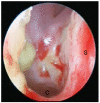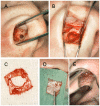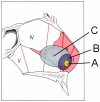Nasal surgery in patients with systemic disorders
- PMID: 22073106
- PMCID: PMC3199829
- DOI: 10.3205/cto000066
Nasal surgery in patients with systemic disorders
Abstract
Multisystemic disorders represent a heterogenous group of diseases which can primarily manifest at the nose and paranasal sinuses as limited disease or secondarily as part of systemic involvement. Rhinologists therefore play an important role in the diagnostic but also therapeutic process. Although therapy of multisystemic disorders is primary systemic, additional rhinosurgery may become necessary. The spectrum of procedures consists of sinus surgery, surgery of the orbit and lacrimal duct, septorhinoplasty and closure of nasal septal perforation. Since the prevalence of most systemic diseases is very rare, recommendations are based on the analysis of single case reports and case series with a limited number of patients only. Although data is still limited, experiences published so far have shown that autologous cartilage or bone grafts can be used in nasal reconstruction of deformities caused by tuberculosis, leprosy, Wegener's granulomatosis, sarcoidosis and relapsing polychondritis. Experiences gained from these diseases support the concept that well-established techniques of septorhinoplasty can be used in systemic diseases as well. However, a state of remission is an essential condition before considering any rhinosurgery in these patients. Even under these circumstances revision surgery has to be expected more frequently compared to the typical collective of patients undergoing septorhinoplasty. In addition, experiences gained from saddle nose reconstruction may in part be of value for the treatment of nasal septal perforations since implantation of cartilage grafts often represents an essential step in multilayer techniques of closure of nasal septal perforations. Aside from the treatment of orbital complications sinus surgery has been proven beneficial in reducing nasal symptoms and increasing quality of life in patients refractory to systemic treatment.
Keywords: nasal septal perforation; rhinoplasty; saddle nose; sinusitis; systemic disorder.
Figures








Similar articles
-
[Nasal surgery in patients with systemic disorders].Laryngorhinootologie. 2010 May;89 Suppl 1:S103-15. doi: 10.1055/s-0029-1246127. Epub 2010 Mar 29. Laryngorhinootologie. 2010. PMID: 20352566 Review. German.
-
Long-term follow-up of repair of external nasal deformities in patients with Wegener's granulomatosis.Laryngoscope. 2002 Apr;112(4):731-7. doi: 10.1097/00005537-200204000-00025. Laryngoscope. 2002. PMID: 12150531
-
Avoiding pitfalls in open augmentation rhinoplasty with autologous L-shaped costal cartilage strut grafts for saddle nose collapse due to autoimmune disease: the Cambridge experience.J Plast Reconstr Aesthet Surg. 2014 Aug;67(8):e195-203. doi: 10.1016/j.bjps.2014.03.029. Epub 2014 Mar 31. J Plast Reconstr Aesthet Surg. 2014. PMID: 24742691
-
Long-term use and follow-up of irradiated homologous costal cartilage grafts in the nose.Arch Facial Plast Surg. 2009 Nov-Dec;11(6):378-94. doi: 10.1001/archfacial.2009.91. Arch Facial Plast Surg. 2009. PMID: 19917899
-
[Nasal septal perforation and systemic disease].Rev Med Interne. 2002 Nov;23(11):919-26. doi: 10.1016/s0248-8663(02)00711-7. Rev Med Interne. 2002. PMID: 12481392 Review. French.
Cited by
-
2021 American College of Rheumatology/Vasculitis Foundation Guideline for the Management of Antineutrophil Cytoplasmic Antibody-Associated Vasculitis.Arthritis Rheumatol. 2021 Aug;73(8):1366-1383. doi: 10.1002/art.41773. Epub 2021 Jul 8. Arthritis Rheumatol. 2021. PMID: 34235894 Free PMC article.
-
The role of surgery in antineutrophil cytoplasmic antibody-associated vasculitides affecting the nose and sinuses: A systematic review.SAGE Open Med. 2020 Jul 1;8:2050312120936731. doi: 10.1177/2050312120936731. eCollection 2020. SAGE Open Med. 2020. PMID: 32676189 Free PMC article. Review.
-
Autoimmune-related nasal septum perforation: A case report and systematic review.Allergy Rhinol (Providence). 2017 Mar 1;8(1):40-44. doi: 10.2500/ar.2017.8.0191. Allergy Rhinol (Providence). 2017. PMID: 28381327 Free PMC article.
-
2021 American College of Rheumatology/Vasculitis Foundation Guideline for the Management of Antineutrophil Cytoplasmic Antibody-Associated Vasculitis.Arthritis Care Res (Hoboken). 2021 Aug;73(8):1088-1105. doi: 10.1002/acr.24634. Epub 2021 Jul 8. Arthritis Care Res (Hoboken). 2021. PMID: 34235880 Free PMC article.
-
[Diagnosis and treatment of ANCA-associated vasculitis : S3 guideline of the German Society for Rheumatology and Clinical Immunology e. V. (DGRh) and German Society for Internal Medicine e. V. (DGIM), German Society for Nephrology e. V. (DGfN), German Society for ENT Medicine and Head and Neck Surgery e. V. (DGHNO-KHC), German Ophthalmological Society e. V. (DOG), German Society for Neurology e. V. (DGN), German Society for Pneumology and Respiratory Medicine e. V. (DGP), German Society for Pathology e. V. (DGP), German Radiological Society, Society for Medical Radiology e. V. (DRG), Federal Association of German Pathologists, Federal Kidney Association e. V., German Rheumatism League Federal Association e. V.].Z Rheumatol. 2025 Apr;84(Suppl 1):1-49. doi: 10.1007/s00393-024-01597-6. Epub 2025 Apr 3. Z Rheumatol. 2025. PMID: 40178542 Review. German. No abstract available.
References
-
- Hup AK, Haitjema T, de Kuijper G. Primary nasal tuberculosis. Rhinology. 2001;39(1):47–48. - PubMed
-
- Prasad KC, Sreedharan S, Chakravarthy Y, Prasad SC. Tuberculosis in the head and neck: experience in India. J Laryngol Otol. 2007;121(10):979–985. doi: 10.1017/S0022215107006913. Available from: http://dx.doi.org/10.1017/S0022215107006913. - DOI - DOI - PubMed
-
- Kim YM, Kim AY, Park YH, Kim DH, Rha KS. Eight cases of nasal tuberculosis. Otolaryngol Head Neck Surg. 2007;137(3):500–504. doi: 10.1016/j.otohns.2007.04.009. Available from: http://dx.doi.org/10.1016/j.otohns.2007.04.009. - DOI - DOI - PubMed
-
- Choi YC, Park YS, Jeon EJ, Song SH. The disappeared disease: tuberculosis of the nasal septum. Rhinology. 2000;38(2):90–92. - PubMed
-
- Lai TY, Liu PJ, Chan LP. Primary nasal tuberculosis presenting with septal perforation. J Formos Med Assoc. 2007;106(11):953–955. doi: 10.1016/S0929-6646(08)60066-2. Available from: http://dx.doi.org/10.1016/S0929-6646(08)60066-2. - DOI - DOI - PubMed
LinkOut - more resources
Full Text Sources

